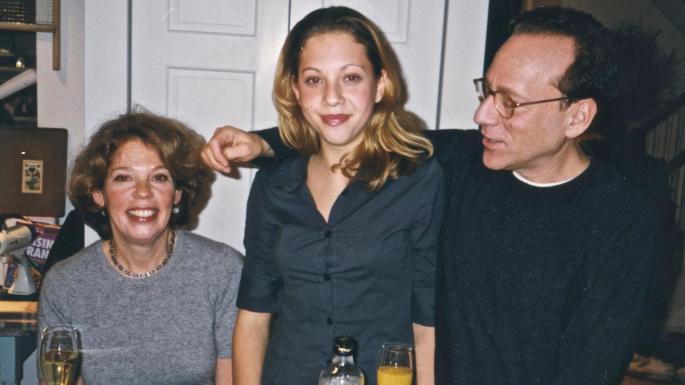Here’s an essay The Times and The Sunday Times of London, asked me to write about The Widower’s Notebook. Read the original article here.

Friday, August 16, 2013 appeared to be a normal day. My wife, Joy, had undergone minor out-patient knee surgery — the routine repairing of a torn tendon — and was resting at home, her leg up, re-reading her notes for Food City, a book she had been writing for several years.
What did we talk about? Dinner? Going away for the weekend? Our daughter? An ordinary day. I went out to buy more ice for Joy’s leg and she switched from research to reading Hilary Mantel’s Wolf Hall.
Earlier she had complained that her leg felt twitchy, and I thought she looked and felt a bit feverish. She called the doctor’s office and was told not to worry and to come in next week for her post-op appointment. “No one wants to be bothered before a summer weekend,” I said, but if the doctor’s office wasn’t worried, neither was Joy.
I went into my studio in the back of our Manhattan flower-market loft, which is a good 100ft away. It’s impossible to hear much over the city’s din, but Joy had her mobile phone. She didn’t call, so after 20 or 30 minutes I decided to check on her.
Halfway down the hall I could see that something was terribly wrong. Joy was reaching out to me, unable to speak, her eyes wide with terror. I rushed to her side. She gripped my arm and gasped for breath. I told her to breathe, to relax, to hold on, while I fumbled with my phone and called 911. How much time passed? Minutes? An hour? I can’t say. I held Joy and repeated: “Breathe, relax, hold on.” Then there were firemen crowding our living room, rolling Joy on to the floor, tearing open her blouse to administer CPR, and I was pushed against a wall, paralysed, a helpless, invisible man.
Soon I was in a car with the fire chief, trailing the ambulance, racing through Manhattan, the siren blaring, going the wrong way down one-way streets. It was a car chase as cinematic as any I have seen in the movies, but I was not watching this one, I was in it.
Then I spent hours alone in a hospital waiting room, pacing, worrying, my mind a shortwave radio picking up pieces of our 40 years together as if they were things I need to preserve. Our first date as art students at Boston University: a party at my apartment, my room-mate in a fist fight, time spent in an emergency room, Joy coming along.
“Some date,” I said as I dropped her off at her dorm. “I’ve had worse,” she said, and pecked me on the cheek. I was already smitten with this calm, sensible girl, with her waist-long auburn hair and freckles. The second date was a lot better: three movies in one night — it turned out we were both movie buffs — beginning with a Luis Buñuel double feature, two of the Spanish director’s darkest films. Afterwards Joy suggested an antidote, so we went to see The Umbrellas of Cherbourg, and she sobbed at the candy-coloured romantic musical of young love lost.
Afterwards, over hours in an all-night coffee shop, we talked of art and movies and what we wanted out of life, with no idea that our lives would include each other. A year later, when Joy moved into my dreary apartment, she decorated my bedroom à la Umbrellas: floral Marimekko curtains, pink and mauve-striped wallpaper. I said: “It looks like a brothel.” She said: “What’s wrong with that?” It was the beginning of a 40-year romance and marriage with all the attendant ups and downs, but ones we weathered and survived, two kids growing up together.
I paced in the hospital waiting room. Then my beautiful 29-year-old daughter, Dorie, arrived. The moment the doctor entered the room I knew before he said, “We did all we could.” My daughter let out a piercing “NO!” and fell against my chest, sobbing, her pain radiating through me like electric shocks. Moments later — or was it hours? — I was in the hall asking the doctor what happened. He said: “We may never know.”
My brain was shrieking: “What do you mean we may never know?” It was the beginning of a medical mystery that would take almost two years to unravel, but I didn’t know that yet. I was numb; signing papers, picking up my wife’s personal effects. Back in the waiting room I was trying to console my daughter while struggling to contain my emotions, both of us sick with grief that had only just begun.
A few days later we had an ad hoc memorial. People crowded into our loft apartment and I was meeting and greeting on automatic, a zombie, although I managed a speech that ended with: “Who is going to tell me when I do something wrong?” People laughed, but I meant it seriously. Joy was my anchor, my compass, the person who kept me honest. Then everyone went home and I was left alone to ride the tidal wave of grief. It is not some set of codified stages, as I have heard or read, but was as if I had jumped out of an aircraft without a parachute. I couldn’t sleep. When I did, I had nightmares. I was besieged with guilt: how could I not have saved my wife? It’s an absurd male fantasy. I have been brought up to believe I should be able to handle any situation, and I maintained that façade of being in control, although I was anything but.
I went out every night, unable to be alone in my empty loft. Late one night, still wide awake, I started keeping notebooks, a private place to record my deepest feelings. It was something I had never done, exploring my emotions. I am a western man with all the clichés that go along with that. Explore my feelings? Are you mad? Yet here they were, spilling out of me, and I was unable to stop them.
I went through the loft and hid all of the photographs; they were too painful to look at. Instead I started making drawings of my wife, my daughter, the three of us. I’m a trained artist so it was something I was comfortable with doing, and was a way to stay close to my wife while concentrating on the line, the tone, everything that makes up a drawing. I knew how to do this and it was comforting.
The drawings mounted up, some sketchy, others detailed. Each drawing I made brought me back to a moment — our wedding day, a summer afternoon with my wife and our baby, everything brought to life through my pencil. I drew my wife and daughter at a party we had for our last wedding anniversary and the night came back in vivid detail — the food, the friends, Joy’s earrings, the short speech I made — and the drawing showed me something I rarely saw: how much my wife and daughter look alike.
When Thanksgiving, Joy’s favourite holiday, rolled around Dorie and I escaped. We flew to Phoenix, then rented a Jeep and drove through the southwest. We walked along the edge of the Grand Canyon (something Joy, afraid of heights, would never do) and rode horses in frigid Canyon de Chelly. It was the first vacation Dorie and I had taken alone, and although we rarely talked about Joy, her ghost was along for the ride.
It was great and sad, the two of us still cocooned within our grief. It became a tradition, these Thanksgiving excursions — to Istanbul, Mexico City and a secluded lake house in upstate New York — but we never discussed our grief or loss. Let me clarify: I never discussed it. I knew my daughter wanted to, but every time she tried I shut her down; I just couldn’t handle her pain. I was still playing the stoic male; an absurd role, but I couldn’t shake it. I played it so well I never asked for help. Some friends bought it and disappeared, thinking I must have wanted to be alone (not true, and I resented them for it); others visited, dragged me out to dinner, constantly invited me over and forced me to talk (and I loved them for it).
For a year I was unable to read, but suddenly I couldn’t stop. They were all grief memoirs and almost all were written by women. I started transcribing my notebooks. I didn’t intend them to be a book, but friends, mostly women, encouraged me. “Men do not write these kinds of books, so you must.” I edited the notebooks. I couldn’t believe I was doing this with something so personal, but once I made the decision that it would be a book I decided it must be the best book I will ever write. I knew Joy would have agreed. I wrote about the torments of grief, the bouts of self-pity, my battle with sleeping pills. I wrote of the pain and, inadvertently, the absurdity and humour. The last was something I didn’t realise until later, when people told me that the book was loaded with laugh-out-loud comedy, and I was glad. Joy never stopped thinking I was funny.
Two years later a good family friend died unexpectedly, a terrible shock, but one that forced Dorie and me to talk. We cried, we laughed and we broke through my stoic mask. It was a revelation; sad but necessary.
After losing his son, Ralph Waldo Emerson wrote, “I grieve that grief can teach me nothing,” and I understand that. In many ways we return to our former life, pick up the pieces, and go forward. But I have learnt from grief; learnt that I can survive it, learnt how to let in pain and loss.
Two decades ago I lost ten years of artwork in a gallery fire. I couldn’t paint, so I started writing. I often say: “I don’t recommend a fire, but it changed my life, and not in a bad way.” Obviously, I would never recommend losing a loved one, although at some point we all do, and I will say this: you will survive. You may not think so and you may not be the same, but you will move forward, and on many occasions you will be happy because you are here and alive with your memories and you now know how precious life is.
The Widower’s Notebook: A Memoir by Jonathan Santlofer is published by Penguin

